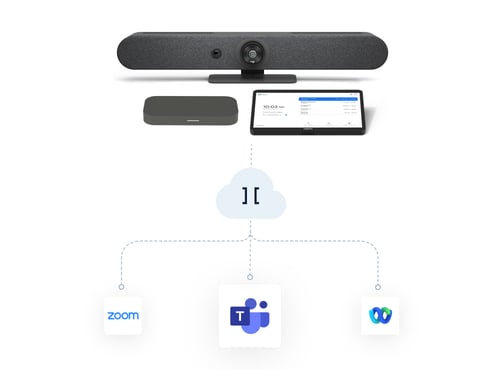Gartner predicts that roughly 30% of patient interactions are expected to be virtual by 2022, meaning that for most healthcare organizations, it’s time to choose a long-term, scalable solution for telehealth. But once you have the technology in place, how do you ensure providers, patients, and decision makers are on board and engaged?
Implementing telehealth requires significant digital transformation of the existing operations. A comprehensive change management program is essential to scaling solutions across specialties and use cases. The Chartis Group breaks down the process well in the Art of Execution: Moving the Organization from Planning to Performance. The investment upfront mitigates future challenges evidenced by an article from Perificient, which found up to 75% of a digital transformation project’s ROI is dependent on the users using the solution the way it’s intended. Here are some tips for implementing a successful adoption strategy.
1. Communicate the benefits of telehealth at the strategic level
A critical factor in almost any change management strategy is communication. After all, many people are not particularly fond of change unless they understand why it’s necessary, how it will benefit them, and what work it entails. This requires a consistently positive message and a clearly communicated strategy targeted at stakeholders from business administrators to clinical leaders. So how do you create alignment within your hospital’s management and educate your staff about the benefits of telehealth?
Start by ensuring you have clear goals and a common understanding of what you’re trying to achieve. Let some of your organization’s highly respected leaders use the technology first and become accustomed to its features and benefits. With hands-on experience, they’ll be well positioned to communicate the purpose and benefits with the rest of the organization.
2. Win over clinicians on telehealth
Clinical users can make or break the success of your telehealth program. Reports suggest that a lack of support from clinicians was a key factor in preventing digital product and service adoption rates prior to Covid-19. The reasons reported included:
- Doubts about the effectiveness of digital alternatives
- A desire to avoid disruptions to their existing workflows
- Concerns about security and liability risks
Clinician adoption rates have improved during the Covid-19 pandemic out of necessity. But as healthcare organizations now plan for long term implementations of telehealth, it’s still important to address these primary concerns. Start by setting reasonable expectations and ensuring the right compensation information and incentives are in place. You should also make sure to have a clear Plan B in place in case processes don’t go as planned, along with transparent information about data security and liability.
Another key factor of successful change management is optimized training paired with readily available technical support. By tracking challenges users face, you’re able to create a continuous feedback loop to improve training, paving the way for smooth adoption. Are you only doing simple point-and-click demonstrations? Go beyond that and include real-world situations that focus on when and how to use different telehealth solutions, with tips and FAQs that are easy to find. Also, be sure not to forget the scheduling and support staff in training processes. Open the channels of communication and encourage early adopters and frequent users to share best practices within the organization. All of this will make help to show clinicians and staff why modern telehealth is a safe and beneficial choice.
3. Choose a telehealth solutions that's easy for patients to use
Think of yourself as a user of new technology. How likely are you to use a digital service if you’re forced to jump through many hoops along the way? Healthcare serves a very diverse population, meaning telemedicine solutions for hospitals and clinics should be easily accessible for all users regardless of how tech-savvy they are. Consider the patient’s perspective and show empathy in your communications about how to use the platform. Providing and receiving care is very personal and often emotional, and for some, even the thought of using digital technology can be frustrating and alienating.
A survey on telemedicine adoption by doctor.com found that 69% of patients would be more likely to use telehealth if the technology is easy to use. So, how simple are your telehealth solutions? It’s critical leverage solutions that make the whole process of virtual visits seamless, from scheduling, to reminders, to the visit itself, to any follow-up information that’s shared. Pre-visit outreach calls to first-time users are also a great way to help patients feel confident and prepared. Finally, when planning your communications strategy don’t forget to consider all types of patients, including those who only speak other languages or who have certain types of disabilities.
Why a flexible video conferencing solution can be the key to success
From clinical leaders, to patients, to many different types of hospital staff, it’s important that the video element of your organization’s telehealth platform works the same way for everyone. Video communication is one of the most critical components of telehealth, providing everything from remote face-to-face visits to allowing doctors to collaborate across distances. Regardless of the use case, the video call should be easy to join and integrated with existing technology and workflows. In other words, it should be just as easy for a doctor to join a video visit from her clinic or home as it is for her to see a patient in person. Driving adoption requires the consideration of many factors, but remember the technology itself should be helping, not hindering your effort. By removing barriers, working seamlessly across a variety of devices and browsers, and providing a truly simple user experience, you’ll be well on your way to successful adoption of your service.
Read more about Pexip Health’s unique approach to simple and interoperable video solutions for healthcare organizations.
- Healthcare
- Digital transformation
- Video Platform





